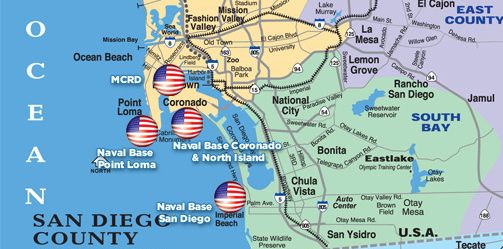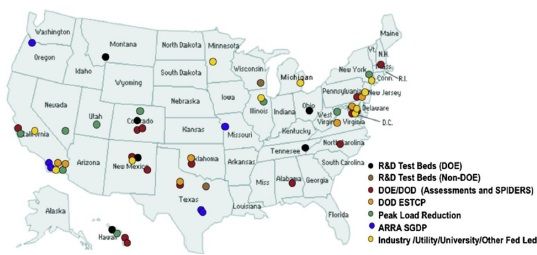Nobody is more interested in microgrids than the U.S. military. The idea of self-sustaining energy islands that can stay on even during grid-wide blackouts is of obvious value to military bases, which can’t let power outages keep them from performing their missions.
But what if those military microgrids could also serve a broader set of purposes, by linking themselves to one another, or even to the grid at large? That’s a question that the U.S. Navy is now striving to answer, via a first-ever project meant to tie three separate microgrids in San Diego, Calif. into a functioning whole.
Power Analytics (formerly EDSA) is the San Diego-based company that won the contract for the project, under the Department of Defense’s Environmental Security Technology Certification Program (ESTCP). While we’ve seen other military microgrids start to connect themselves to the grid, this will be the “first centrally managed cluster of multiple cyber-secure military microgrids” in the country, according to last week’s press release. Financial terms of the three-year contract weren't disclosed, but Karen Cronin, Power Analytics vice president, told the San Diego Union-Tribune that it was more than $2 million.
Power Analytics is a long-time Navy partner, and is now helping combine the three San Diego microgrids into a “secure cluster” of microgrids, to help the Navy both improve energy supply security and reduce its overall energy consumption.
Kevin Meagher, Power Analytics president and CTO, said in an interview last week that the three microgrids, at the hospital at Naval Base San Diego, a data center at Naval Base Coronado and at Naval Base Point Loma, are now equipped with the on-site generation, solar power, energy storage and grid controls they need.

“The circuits are there; for the most part, all of the hardware is there,” Meagher said. “The trick to doing this is to take the existing circuits, the existing equipment, and figure out how to make it all work to meet the requirements” of the project, which are to provide the “first comprehensive, real-time view of the status of its critical power systems across multiple bases.”
Meagher broke down the project’s imperatives into three broad categories. First, “it clearly presents the opportunity for a cluster of microgrids from an economic perspective,” to do things like “wheel” power from base to base, or to optimize the way the combination of microgrids draws from the grid at certain times, versus relying on their own generation and energy storage capabilities.
Second, "Because of the synchronization of the data, it allows you to talk about enhancing or modifying the structure, either to enhance stability at a specific microgrid, or not, depending on what happens on each of the bases,” he said. In other words, it’s a way to study not just what the cluster can do as presently configured, but how it can be changed to maximize that potential.
“The third thing is the same thing that everyone talks about, but it’s still very near and dear to the Department of Defense -- that’s situational awareness,” he said. In other words, this microgrid cluster is meant to be an “early warning system,” to allow the Navy to predict and prepare for power disruptions, whether they stem from the grid they’re connected to, or from internal changes like routine maintenance of various systems.
The work being done by the U.S. military on microgrids will doubtless help lay the groundwork for the spread of the technologies involved to the private sector. GTM Research has collected some data from DOD’s microgrid programs, which include R&D into the hardware involved, as well as the system integration and economic analysis software that makes them run.

Military microgrid developers include SAIC, Lockheed Martin, Raytheon, Boeing and General Electric, which is already in a big microgrid project with the U.S. Marine Corps. DOD and the Department of Energy are also working on standardizing the technologies that go into microgrids, via the Smart Power Infrastructure Demonstration for Energy Reliability and Security (SPIDERS) projects underway at Fort Carson, Colorado, and at Pearl Harbor-Hickam Air Force Base and Camp Smith in Hawaii.
Building economically feasible, grid-interactive microgrids is the next step in this process. We’re seeing projects around the world testing the ability of locally controlled energy systems to balance the grid at large, with grid giants like GE, ABB, Siemens, Alstom, Schneider Electric, Toshiba and Hitachi, startups like Blue Pillar, Viridity Energy, Powerit Solutions and Enbala, and technology firms such as Spirae, Integral Analytics and Power Analytics all taking different tacks on the challenge. Power Analytics' software, for its part, is used by financial data centers, air traffic control sites, military installations, deep-sea oil platforms, and power generation and distribution facilities worth a collective $120 billion in asset value.
San Diego is emerging as a key test bed for combining government, institutional and utility microgrids into a working whole. Beyond the Navy projects, the University of California at San Diego has built a cutting-edge microgrid that supplies 90 percent of the campus’ power needs. UCSD’s microgrid, in turn, is being integrated into a larger microgrid project with utility San Diego Gas & Electric, which has already tapped UCSD’s capabilities to help it avoid blackouts during a major fire that threatened power lines.
While the Navy project isn't yet looking at how its microgrids could play a role in that kind of utility stability assistance on an ongoing basis, Meagher said it's definitely part of what Power Analytics is trying to figure out.
"The Department of Defense has recognized for a long time that it has an opportunity to advance technology, and the allocation of that, for the entire community," he said. "This is very much in that vein, where they see a huge upside potential to this."



